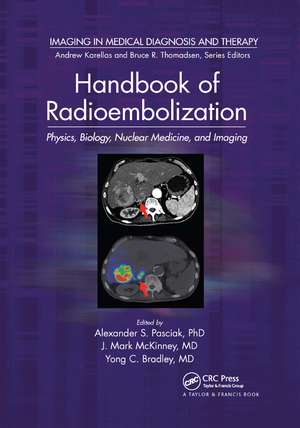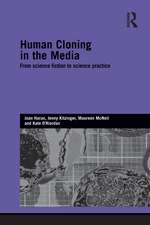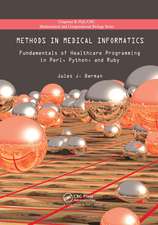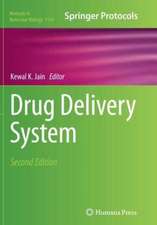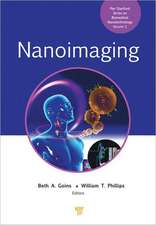Handbook of Radioembolization: Physics, Biology, Nuclear Medicine, and Imaging: Imaging in Medical Diagnosis and Therapy
Editat de PhD. Pasciak, MD. Bradley, MD. McKinneyen Limba Engleză Paperback – 12 dec 2019
Din seria Imaging in Medical Diagnosis and Therapy
- 9%
 Preț: 572.73 lei
Preț: 572.73 lei - 5%
 Preț: 338.81 lei
Preț: 338.81 lei -
 Preț: 436.14 lei
Preț: 436.14 lei -
 Preț: 439.47 lei
Preț: 439.47 lei - 16%
 Preț: 302.11 lei
Preț: 302.11 lei -
 Preț: 479.68 lei
Preț: 479.68 lei - 15%
 Preț: 317.92 lei
Preț: 317.92 lei - 11%
 Preț: 332.93 lei
Preț: 332.93 lei - 14%
 Preț: 326.37 lei
Preț: 326.37 lei - 17%
 Preț: 296.80 lei
Preț: 296.80 lei - 11%
 Preț: 321.92 lei
Preț: 321.92 lei - 12%
 Preț: 317.92 lei
Preț: 317.92 lei - 15%
 Preț: 427.16 lei
Preț: 427.16 lei - 10%
 Preț: 326.09 lei
Preț: 326.09 lei - 30%
 Preț: 820.03 lei
Preț: 820.03 lei - 17%
 Preț: 296.80 lei
Preț: 296.80 lei - 5%
 Preț: 426.94 lei
Preț: 426.94 lei - 25%
 Preț: 610.27 lei
Preț: 610.27 lei - 15%
 Preț: 461.03 lei
Preț: 461.03 lei - 22%
 Preț: 477.32 lei
Preț: 477.32 lei - 12%
 Preț: 313.61 lei
Preț: 313.61 lei - 18%
 Preț: 299.92 lei
Preț: 299.92 lei - 12%
 Preț: 315.28 lei
Preț: 315.28 lei - 5%
 Preț: 1548.34 lei
Preț: 1548.34 lei - 12%
 Preț: 317.18 lei
Preț: 317.18 lei - 21%
 Preț: 415.10 lei
Preț: 415.10 lei -
 Preț: 463.13 lei
Preț: 463.13 lei - 16%
 Preț: 312.43 lei
Preț: 312.43 lei - 25%
 Preț: 434.76 lei
Preț: 434.76 lei - 11%
 Preț: 321.33 lei
Preț: 321.33 lei -
 Preț: 449.25 lei
Preț: 449.25 lei - 10%
 Preț: 325.33 lei
Preț: 325.33 lei - 13%
 Preț: 322.04 lei
Preț: 322.04 lei - 18%
 Preț: 1118.04 lei
Preț: 1118.04 lei - 17%
 Preț: 464.79 lei
Preț: 464.79 lei - 15%
 Preț: 317.58 lei
Preț: 317.58 lei
Preț: 359.61 lei
Nou
Puncte Express: 539
Preț estimativ în valută:
68.83€ • 74.79$ • 57.86£
68.83€ • 74.79$ • 57.86£
Carte disponibilă
Livrare economică 31 martie-14 aprilie
Livrare express 15-21 martie pentru 43.45 lei
Preluare comenzi: 021 569.72.76
Specificații
ISBN-13: 9780367874681
ISBN-10: 0367874687
Pagini: 348
Dimensiuni: 178 x 254 x 19 mm
Greutate: 0.73 kg
Ediția:1
Editura: CRC Press
Colecția CRC Press
Seria Imaging in Medical Diagnosis and Therapy
Locul publicării:Boca Raton, United States
ISBN-10: 0367874687
Pagini: 348
Dimensiuni: 178 x 254 x 19 mm
Greutate: 0.73 kg
Ediția:1
Editura: CRC Press
Colecția CRC Press
Seria Imaging in Medical Diagnosis and Therapy
Locul publicării:Boca Raton, United States
Cuprins
INTRODUCTION. Introduction to radioembolization for the treatment of non-resectable liver cancer. PATIENT SELECTION AND TREATMENT PLANNING. Treatment options for patients with primary and secondary liver cancer: An overview of invasive, minimally invasive and non-invasive techniques. Treatment planning part I: Vascular considerations. Treatment planning part II: Procedure simulation using 99mTc-MAA. Treatment planning part III: Dosimetric considerations in conventional lobar therapy. Treatment planning part IV: Radioembolization in segmentectomy, lobectomy and future liver remnant hypertrophy. TREATING PATIENTS WITH RADIOEMBOLIZATION. Radiation safety concerns associated with preparing the dose, treating and releasing the patient and managing radioactive waste. The radiation biology of radioembolization. Glass and resin microspheres: An analysis on a microscopic and macroscopic level. FOLLOWING PATIENTS TREATED WITH RADIOEMBOLIZATION. Quantitative post-radioembolization imaging using Bremsstrahlung SPECT. Quantitative post-radioembolization imaging using PET/CT. Image-based 3-dimensional dosimetry following radioembolization. Diagnostic reporting using post-radioembolization imaging. Using post-treatment imaging in the medical management of patients treated with radioembolization. The potential utility of serial therapy in radioembolization: A radiation biology analysis. NEW HORIZONS. Future directions in radioembolization for intrahepatic and extrahepatic treatment of disease
Notă biografică
Alexander S. Pasciak, PhD, earned a BS in electrical engineering at the University of Washington, MS in health physics and PhD in nuclear engineering at Texas A&M University. In 2010, Dr. Pasciak completed a 2-year diagnostic medical physics residency at the University of Texas MD Anderson Cancer Center after which he worked for 5 years as a diagnostic medical physicist at the University of Tennessee Medical Center in Knoxville, Tennessee. Dr. Pasciak maintains a position as an associate professor of radiology at the University of Tennessee and is concurrently pursuing his MD degree at the Johns Hopkins University School of Medicine in Baltimore, Maryland. Dr. Pasciak is active in multiple research endeavors in the fields of interventional radiology and medical physics, and he has published papers in high impact journals. Dr. Pasciak has published 35 articles in peer-reviewed medical journals, presented 62 research abstracts at national meetings, has written 6 book chapters, and has filed 2 patents. He currently serves as principal investigator on three externally funded research grants involving radioembolization. Dr. Pasciak is certified by the American Board of Radiology (ABR) in diagnostic medical physics and is Mammography Quality Standards Act (MQSA) qualified.
J. Mark McKinney, MD, earned a medical degree at Loma Linda University School of Medicine in California where he completed a diagnostic radiology residency and interventional radiology fellowship. Dr. McKinney joined the Mayo Clinic in 1993. While at Mayo Clinic in Jacksonville, Florida, he developed the interventional radiology fellowship, mentored residents, made numerous presentations, and authored more than 60 peer-reviewed articles, abstracts, and book chapters. From 2008 to 2012 Dr. McKinney was Chair of Radiology at the University of Tennessee Medical Center and initiated the University of Tennessee interventional oncology radioembolization program.
J. Mark McKinney, MD, earned a medical degree at Loma Linda University School of Medicine in California where he completed a diagnostic radiology residency and interventional radiology fellowship. Dr. McKinney joined the Mayo Clinic in 1993. While at Mayo Clinic in Jacksonville, Florida, he developed the interventional radiology fellowship, mentored residents, made numerous presentations, and authored more than 60 peer-reviewed articles, abstracts, and book chapters. From 2008 to 2012 Dr. McKinney was Chair of Radiology at the University of Tennessee Medical Center and initiated the University of Tennessee interventional oncology radioembolization program.
Recenzii
"This book will be a valuable resource for anyone already in the field of radioembolisation, whether it be for clinical or scientific guidance, as well as those just starting up and wishing to familiarise themselves with the procedure. It offers detailed insight into the many facets that contribute to successful therapy, and through its multidisciplinary nature promises be a useful tool in improving safety and efficacy of treatment, and establishing a personalised approach to radioembolisation."
—Dr. Kathy Willowson, The University of Sydney
"An essential book for anybody who is involved or is planning to start Y-90 radioemboliziation, covering state-of-the-art dosimetry approaches using bremsstrahlung SPECT/CT and PET/CT imaging, with excellent descriptions of advantages and limitations."
—Dr. Karin Knešaurek, Department of Radiology, Icahn School of Medicine, Mount Sinai Hospital
"a comprehensive yet practical study of selective internal radiation therapy. Representing the latest concepts and research relating to radioembolization, the book takes the reader through the basics in a logical and cohesive manner. The authors have managed to present complex topics and arms of controversy in an objective, scientific and honest manner, allowing the reader to adapt and evolve with the thought processes behind various advanced therapeutic strategies. This text should be part of a core curriculum for those users starting SIRT, and advanced users alike."
—David Liu, MD, Vancouver Imaging Inc and University of British Columbia
"a well written book on principles and practice of hepatic radioembolization, with excellent emphasis on dosimetry, radiobiology and post-therapy imaging. I strongly recommend this to all physicians engaged in treating liver tumors with radioembolization."
—Sanjeeva Kalva, MD, University of Texas Southwestern Medical Center
"provides a det
—Dr. Kathy Willowson, The University of Sydney
"An essential book for anybody who is involved or is planning to start Y-90 radioemboliziation, covering state-of-the-art dosimetry approaches using bremsstrahlung SPECT/CT and PET/CT imaging, with excellent descriptions of advantages and limitations."
—Dr. Karin Knešaurek, Department of Radiology, Icahn School of Medicine, Mount Sinai Hospital
"a comprehensive yet practical study of selective internal radiation therapy. Representing the latest concepts and research relating to radioembolization, the book takes the reader through the basics in a logical and cohesive manner. The authors have managed to present complex topics and arms of controversy in an objective, scientific and honest manner, allowing the reader to adapt and evolve with the thought processes behind various advanced therapeutic strategies. This text should be part of a core curriculum for those users starting SIRT, and advanced users alike."
—David Liu, MD, Vancouver Imaging Inc and University of British Columbia
"a well written book on principles and practice of hepatic radioembolization, with excellent emphasis on dosimetry, radiobiology and post-therapy imaging. I strongly recommend this to all physicians engaged in treating liver tumors with radioembolization."
—Sanjeeva Kalva, MD, University of Texas Southwestern Medical Center
"provides a det
Descriere
Radioembolization is now the preferred treatment for both primary and secondary liver cancer. This handbook addresses the radiation biology, physics, nuclear medicine, and imaging for radioembolization using Yttrium-90 (90Y) microspheres, in addition to discussing aspects related to interventional radiology. The contents reflect new on-label hep
